Active Optic units. Starlight Express https://www.sxccd.com/active-optics/I've got an EQ6-R that can guide 0.5 rms - 0 .4 rms but that really doesn't work well with my reduced C8 @ 1450mm - 0.53"/px. I feel that if I could halve my rms to 0.25 rms - 0.2 rms then things might be better for me. Can anyone with direct experience using one of these devices give me some feedback on how well they work? Thanks!
|
You cannot like this item. Reason: "ANONYMOUS".
You cannot remove your like from this item.
Editing a post is only allowed within 24 hours after creating it.
You cannot Like this post because the topic is closed.
Copy the URL below to share a direct link to this post.
This post cannot be edited using the classic forums editor.
To edit this post, please enable the "New forums experience" in your settings.
I assume you looked into belt mods and such? Just mentioning In case you haven't  |
You cannot like this item. Reason: "ANONYMOUS".
You cannot remove your like from this item.
Editing a post is only allowed within 24 hours after creating it.
You cannot Like this post because the topic is closed.
Copy the URL below to share a direct link to this post.
This post cannot be edited using the classic forums editor.
To edit this post, please enable the "New forums experience" in your settings.
The EQ6-R PRO is not the EQ6. https://www.skywatcherusa.com/products/eq6-r-proThe EQ6-R has belt driven stepper motors from the factory. I have looked into "hypertuning" the mount, but that just means replacing the bearings. My mount is fairly new so I believe my bearings are fine. I did adjust the bearing pre-load on the RA and DEC axis (it was super tight) and then carefully tuned the backlash out of both worm gears using the little push-pull grub screws, and then tightened up the belt tension such that it deflects about a 1mm - 2mm. After this work I still have pretty high periodic error of about 26" - 28" so I was thinking the tip-tilt device could help guide that out instead of having the motors trying to push something like 80lbs (scope + head + counterweights) around. The mount does guide pretty consistently around 0.5" sometimes down into the lower 0.4 upper 0.3 for short spells. I'm hoping that tip/tilt could better that by about 20% - 25% to around 0.3" rms (or better). Anyone with direct experience with this gizmo; I'd love to hear from you.
|
You cannot like this item. Reason: "ANONYMOUS".
You cannot remove your like from this item.
Editing a post is only allowed within 24 hours after creating it.
You cannot Like this post because the topic is closed.
Copy the URL below to share a direct link to this post.
This post cannot be edited using the classic forums editor.
To edit this post, please enable the "New forums experience" in your settings.
Yes I’ve used one to compensate for differential flexure on my dual rig. Works fine.
|
You cannot like this item. Reason: "ANONYMOUS".
You cannot remove your like from this item.
Editing a post is only allowed within 24 hours after creating it.
You cannot Like this post because the topic is closed.
Copy the URL below to share a direct link to this post.
This post cannot be edited using the classic forums editor.
To edit this post, please enable the "New forums experience" in your settings.
I have used the SX AO unit for years with my SCTs and get great results with it. I control the AO through PHD2 guiding software which works quite well.
Clear skies,
Kevin
|
You cannot like this item. Reason: "ANONYMOUS".
You cannot remove your like from this item.
Editing a post is only allowed within 24 hours after creating it.
You cannot Like this post because the topic is closed.
Copy the URL below to share a direct link to this post.
This post cannot be edited using the classic forums editor.
To edit this post, please enable the "New forums experience" in your settings.
Kevin Dixon:
I have used the SX AO unit for years with my SCTs and get great results with it. I control the AO through PHD2 guiding software which works quite well.
Clear skies,
Kevin Kevin, thanks for your reply. Do you happen to know the optical backfocus of the device only using the included M42 adapters on both ends? I want to put it on the end of Starizona SCTCORR-4. I can take the tilt plate off my existing OAG/filterwheel/ares-m camera to gain an extra 5 mm (50 mm instead of 55 mm). The SCRCORR-4 requires 90.3mm +/- 2mm which leaves 40.3mm +/- 2mm for the AO device. from what I can tell from their drawings (which don’t include their device-only optical path distance but instead distances with their OAG) it’s going to be tight.
|
You cannot like this item. Reason: "ANONYMOUS".
You cannot remove your like from this item.
Editing a post is only allowed within 24 hours after creating it.
You cannot Like this post because the topic is closed.
Copy the URL below to share a direct link to this post.
This post cannot be edited using the classic forums editor.
To edit this post, please enable the "New forums experience" in your settings.
It's 44mm when I last used it, plus the adapter on the front flange.
|
You cannot like this item. Reason: "ANONYMOUS".
You cannot remove your like from this item.
Editing a post is only allowed within 24 hours after creating it.
You cannot Like this post because the topic is closed.
Copy the URL below to share a direct link to this post.
This post cannot be edited using the classic forums editor.
To edit this post, please enable the "New forums experience" in your settings.
I used it on my Losmandy GH8 with a 700mm focal length refractor. it improved guiding immensely .
|
You cannot like this item. Reason: "ANONYMOUS".
You cannot remove your like from this item.
Editing a post is only allowed within 24 hours after creating it.
You cannot Like this post because the topic is closed.
Copy the URL below to share a direct link to this post.
This post cannot be edited using the classic forums editor.
To edit this post, please enable the "New forums experience" in your settings.
John Stone:
The EQ6-R PRO is not the EQ6. https://www.skywatcherusa.com/products/eq6-r-pro
The EQ6-R has belt driven stepper motors from the factory.
I have looked into "hypertuning" the mount, but that just means replacing the bearings. My mount is fairly new so I believe my bearings are fine. I did adjust the bearing pre-load on the RA and DEC axis (it was super tight) and then carefully tuned the backlash out of both worm gears using the little push-pull grub screws, and then tightened up the belt tension such that it deflects about a 1mm - 2mm.
After this work I still have pretty high periodic error of about 26" - 28" so I was thinking the tip-tilt device could help guide that out instead of having the motors trying to push something like 80lbs (scope + head + counterweights) around.
The mount does guide pretty consistently around 0.5" sometimes down into the lower 0.4 upper 0.3 for short spells.
I'm hoping that tip/tilt could better that by about 20% - 25% to around 0.3" rms (or better).
Anyone with direct experience with this gizmo; I'd love to hear from you. I think you're on to something here. We have the same mount and I've seen RMS numbers as low as 0.28". It sat in the low 0.3" for a few hours last night. I have had nights where with the exact same setup, it would bang around between 0.75" and 0.6". I really believe that the difference is totally seeing related. That tells me that the mount is mechanically capable of guiding in the high 0.2" range with no outside disturbances. I can't afford the active optics option but I am looking at other ways to mitigate the effect of bad seeing on guiding. Given all that, I do think active optics would be a good solution for you.
|
You cannot like this item. Reason: "ANONYMOUS".
You cannot remove your like from this item.
Editing a post is only allowed within 24 hours after creating it.
You cannot Like this post because the topic is closed.
Copy the URL below to share a direct link to this post.
This post cannot be edited using the classic forums editor.
To edit this post, please enable the "New forums experience" in your settings.
Kevin Dixon:
have used the SX AO unit for years with my SCTs and get great results with it. I control the AO through PHD2 guiding software which works quite well I have two of these, a main unit and a spare. I have used them on a TOA 130/Paramount ME, an AGO 10 inch iDK/Paramount ME, and currently on a Planewave CDK 14/Planewave L350. They work great but do take a bit of getting used to in terms of setup and operation. Once that is done they work very well. I have used the original SBIG mirror type AO as well back in the day but SBIG is kind of yesterday's news and I have not used one of theirs in years. The SX unit will work with pretty much any camera and OAG if you have the right adapters, usually from Precise Parts. I chose it because it works great with PhD. That is mostly because one of the original PhD programmers, Andy Glasso, had one and that was used to develop the support for it within PhD. I would ignore all the nonsense about "high speed guiding" using teeny sub-second guide exposures to give you clearer images. It will do nothing for crap seeing. That will cause more problems than it solves. Treat it as an "optical guider" that takes some of the load off the mount. It is easier to move a one oz. glass plate precisely than a 50-150 pound mount. I typically use guide exposures between 5 and 7 seconds with my CDK (2563 mm) but that is with a high end direct drive mount that already has great tracking. In fact, it will help with a poor mount but will not totally fix a bad mount because that would involve the aforementioned short guide times that are best avoided for many reasons. The bottom line is that it makes guiding less "fussy" even with a good mount and with a less than ideal mount may help at least some, although that has it's limits. Current setup with Nightcrawler and Astrodon MMOAG and Moravian camera shown: FYI, on a good night I typically see in the vicinity of .15 arcsec, on an average night maybe .25 arcsec and on a poor night about .35 or more. Of course that is more seeing and/or wind than anything and is also at a good site with high end mount and optics. I am actually a bit surprised more people don't use these but then most people probably use refractors that are well under 1000 mm where AO would not be of much benefit. I would put the break point where they are worthwhile at about that focal length. 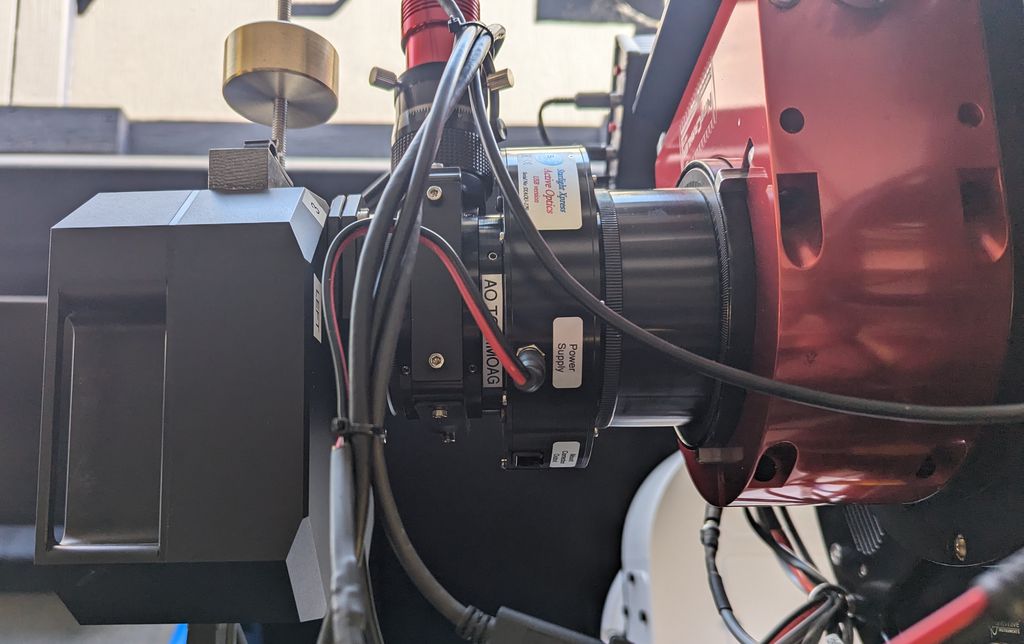 |
You cannot like this item. Reason: "ANONYMOUS".
You cannot remove your like from this item.
Editing a post is only allowed within 24 hours after creating it.
You cannot Like this post because the topic is closed.
Copy the URL below to share a direct link to this post.
This post cannot be edited using the classic forums editor.
To edit this post, please enable the "New forums experience" in your settings.
andrea tasselli:
It's 44mm when I last used it, plus the adapter on the front flange. The refractive plate is also quite thick (as it needs to be) so one needs to take that into account as well when calculating back focus for adapters.
|
You cannot like this item. Reason: "ANONYMOUS".
You cannot remove your like from this item.
Editing a post is only allowed within 24 hours after creating it.
You cannot Like this post because the topic is closed.
Copy the URL below to share a direct link to this post.
This post cannot be edited using the classic forums editor.
To edit this post, please enable the "New forums experience" in your settings.
Those who use the AO unit from Starlight Xpress, have you had trouble with your calibration frames? After fiddling with one for a while I finally started to use it an anger last night and in the morning when I stacked my subs I noticed circular gradients throughout the field. I took a look at the mast flats and this is what I'm seeing: red: 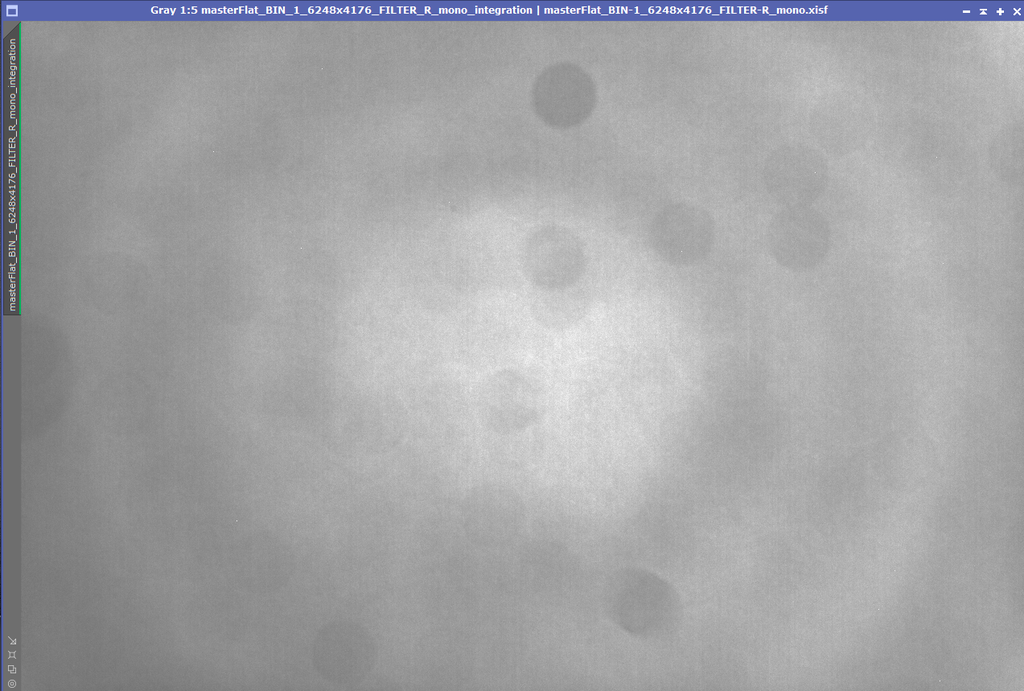 Green: 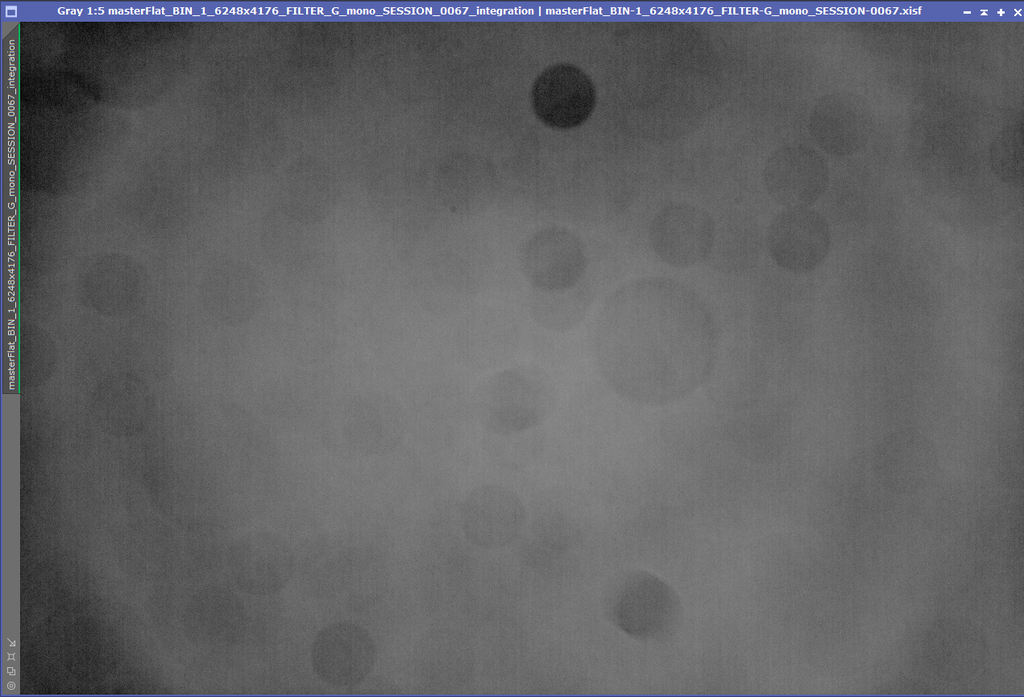 Blue: 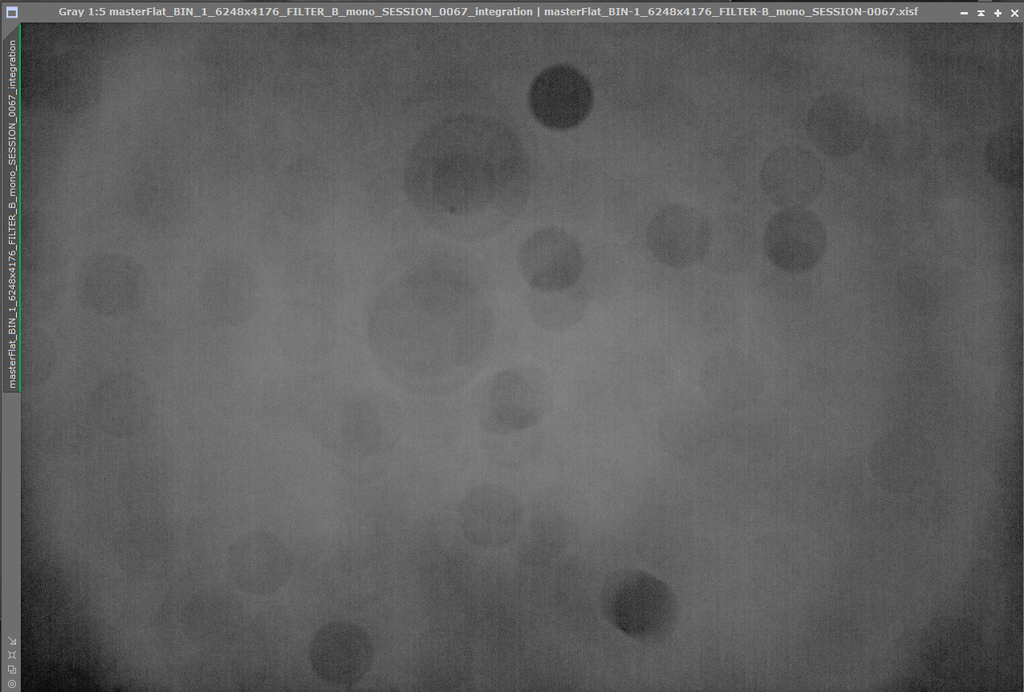 Lum: 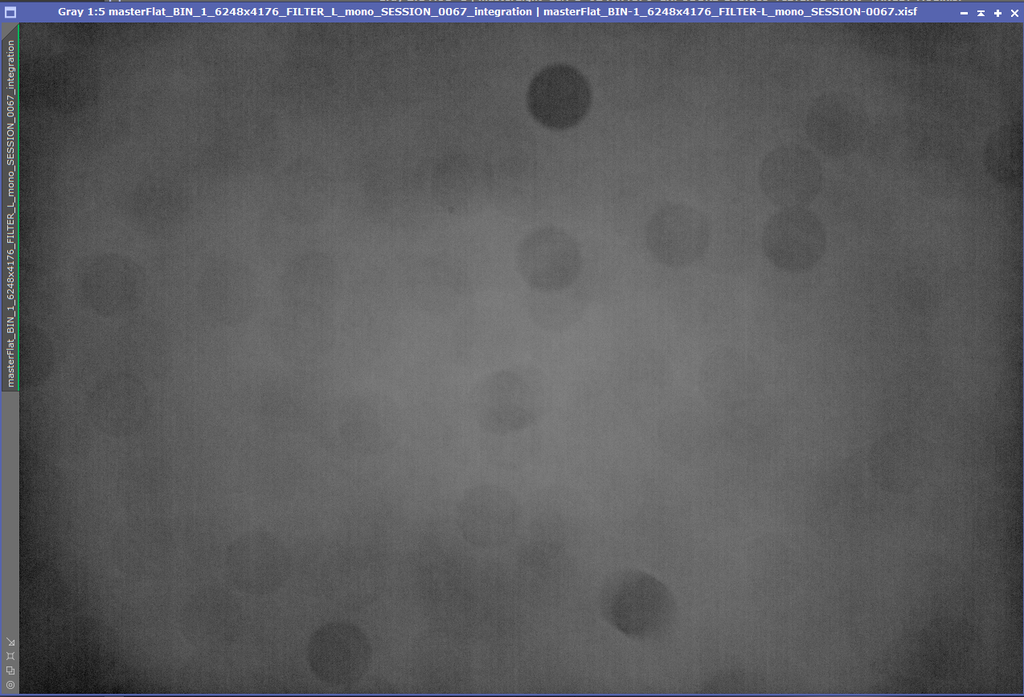 And here's what a Red flat looked like before I installed the AO device: 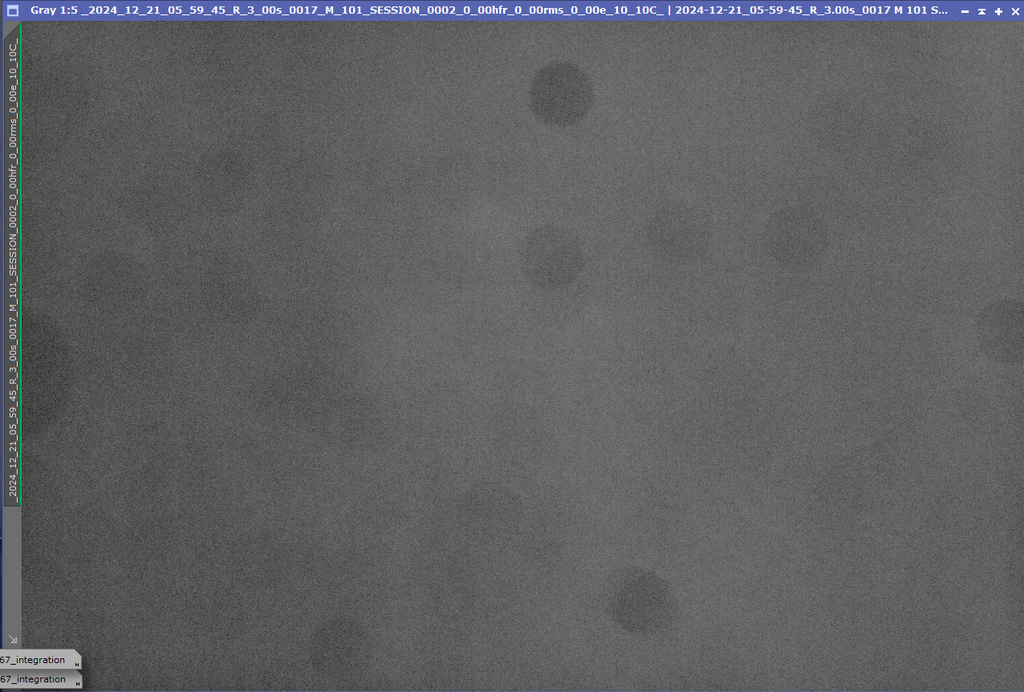 And those circular gradients are showing up in my masters: red master: 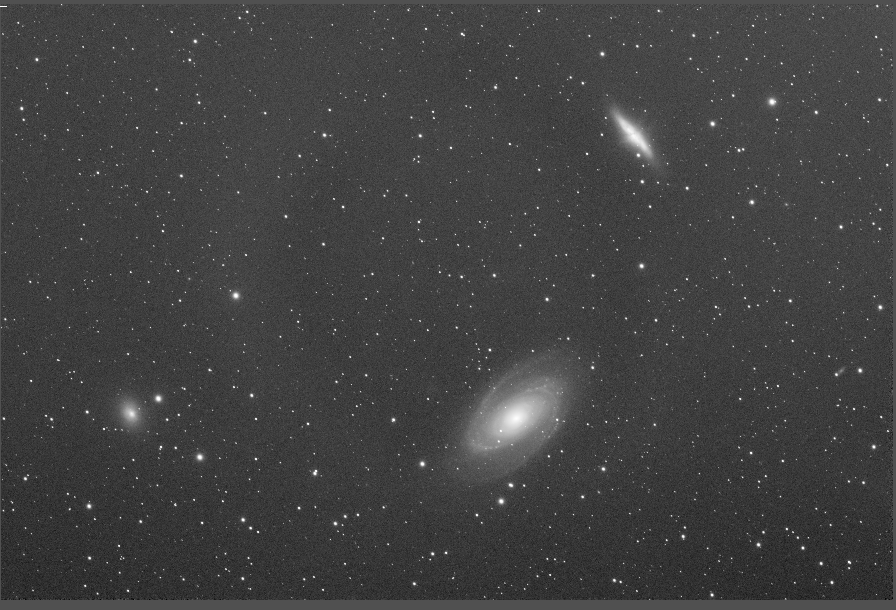 Got a nice fat circular gradient that aligns exactly with the flat. I'm fearful that the light from the image was taken at a different "tip" angle than the light from the flat and what I'm seeing is the master is the residual. Has anyone else had a similar problem with these devices? @Bill McLaughlin Can you provide any feedback? Thanks.
|
You cannot like this item. Reason: "ANONYMOUS".
You cannot remove your like from this item.
Editing a post is only allowed within 24 hours after creating it.
You cannot Like this post because the topic is closed.
Copy the URL below to share a direct link to this post.
This post cannot be edited using the classic forums editor.
To edit this post, please enable the "New forums experience" in your settings.
I have not seen any issues like that. I do always take the flats with the AO powered up and connected to Phd (which centers it), but of course not guiding. I suppose it is possible that the tip/tilt plate was in an odd position for the flats. Or maybe some interaction with the Paracorr, but who knows?
|
You cannot like this item. Reason: "ANONYMOUS".
You cannot remove your like from this item.
Editing a post is only allowed within 24 hours after creating it.
You cannot Like this post because the topic is closed.
Copy the URL below to share a direct link to this post.
This post cannot be edited using the classic forums editor.
To edit this post, please enable the "New forums experience" in your settings.
Yes, this was taken with the AO device powered immediately after all the subs for the target were taken (via the "Immediate Flats" instruction of the Target Scheduler plugin)
The AO unit is connected to the focuser tube of an Askar 107PHQ (petzval design) so it's quite far from the lens elements in the telescope and the OAG/FW/Cam is attached directly to the other side like shown in your picture.
I'm assuming the FW is built in to your camera?
|
You cannot like this item. Reason: "ANONYMOUS".
You cannot remove your like from this item.
Editing a post is only allowed within 24 hours after creating it.
You cannot Like this post because the topic is closed.
Copy the URL below to share a direct link to this post.
This post cannot be edited using the classic forums editor.
To edit this post, please enable the "New forums experience" in your settings.
John Stone:
Active Optic units. Starlight Express https://www.sxccd.com/active-optics/
I've got an EQ6-R that can guide 0.5 rms - 0 .4 rms but that really doesn't work well with my reduced C8 @ 1450mm - 0.53"/px. I feel that if I could halve my rms to 0.25 rms - 0.2 rms then things might be better for me.
Can anyone with direct experience using one of these devices give me some feedback on how well they work?
Thanks! Your RMS would have been fine at that pixel scale, as the oscillation is below the pixels resolution. Seeing is your biggest issue, but the AO can help with that too. My 6R guides similar and I end up being close to diffraction limited at .58" pixel scale on my EdgeHD 8. As for the flats issue, you have introduced another optical element, and as far as I can tell, it seems to not be optically flat or transparent either, which can cause issues with the flats. Another theory is internal reflections from the AO itself.
|
You cannot like this item. Reason: "ANONYMOUS".
You cannot remove your like from this item.
Editing a post is only allowed within 24 hours after creating it.
You cannot Like this post because the topic is closed.
Copy the URL below to share a direct link to this post.
This post cannot be edited using the classic forums editor.
To edit this post, please enable the "New forums experience" in your settings.









